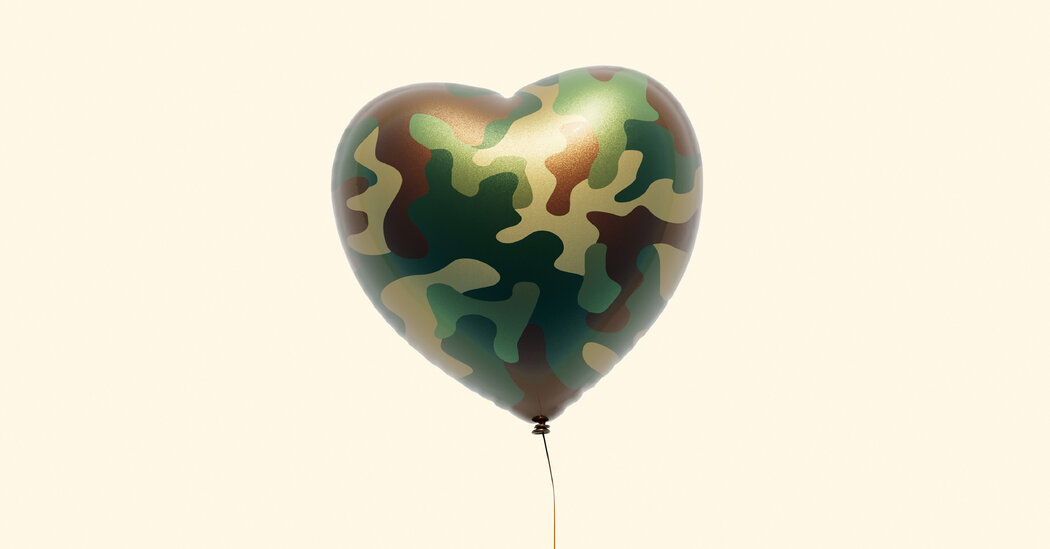There’s an arresting quotation that resurfaces online now and again, usually accompanied by a photograph of a dark-haired woman with an intense gaze: “The death of human empathy is one of the earliest and most telling signs that a culture is about to fall into barbarism.” It’s followed by the name of the woman in the picture: the political philosopher Hannah Arendt, who fled the barbarism of Nazi Germany.
Only there’s no record of Arendt ever saying that, or anything like it. The bogus quotation is the kind of artifact that flourishes on the internet in bewildering times — plausible-sounding and politically ominous. It happens to dovetail with a liberal argument that has flourished in the age of Trump: That the MAGA movement is actively promoting callousness and cruelty. Trump’s critics say supporting examples aren’t hard to come by: the gutting of lifesaving aid to the poor and the sick, the violent crackdown on immigrants, the gleefully sadistic memes. The implication is that one side is committed to empathy while the other side is not.
This would sound like a bit of self-serving liberal propaganda if it weren’t for the fact that a number of prominent figures on the right seem to agree. In February, when Elon Musk went on Joe Rogan’s podcast, Musk derided Democrats for succumbing to “suicidal empathy.” Caring about others, the men agreed, had gotten so out of control that it was becoming self-destructive. “The fundamental weakness of Western civilization is empathy,” Musk said. “They’re exploiting a bug in Western civilization, which is the empathy response.”
Musk likes to refer to other humans as “NPCs,” or “non-player characters.” Such contempt for fellow feeling seems to be gaining ground. The Times Opinion columnist David French has noted how empathy for others — seemingly inextricable from loving thy neighbor as thyself — has come under direct attack by some right-wing Christians. Last year, the Christian podcaster Allie Beth Stuckey published “Toxic Empathy,” which hit the best-seller list; more recently, the pastor Joe Rigney published “The Sin of Empathy.” Both books depict calls for empathy as the work of manipulative progressives trying to inveigle Christians into supporting progressive policies.
But progressives, it turns out, have had their own critiques of empathy over the years. After the 2016 election, Democrats debated how much empathy they should extend to the new president’s supporters. A steady stream of media stories parsed feelings of “economic anxiety” among the white working class. Journalists listening intently to Trump voters in small-town diners became part of what the literary critic Jennifer Wilson called the Empathy Industrial Complex. (McSweeney’s parodied the genre with the headline “I Traveled to a Diner in Trump Country to Write Another Article on Whether the President’s Supporters Still Want to, Quote, ‘Smash My Libtard Face In.’”) Some critics on the left argued that empathy was perfectly suited to a bland centrist complacency: a fixation on feelings with little action to show for it.
Empathy has had a strange journey over the last decade. It has been variously assailed as too parochial, too indiscriminate, too feeble, too powerful. It has also been held out as the key to kindness and a bulwark against atrocity. How did empathy become so politically fraught?
The Empathy Muscle
The word “empathy” has its own curious history. It first appeared in English in 1908, as a translation of Einfühlung, meaning “in-feeling” or “feeling into,” a term from German aesthetics. But the idea it more typically conveys — imagining oneself into the feelings of someone else — was already in circulation. In the 18th century, Adam Smith used the word “sympathy” to refer to that capacity to think about another person “and become in some measure the same person with him, and thence form some idea of his sensations, and even feel something which, though weaker in degree, is not altogether unlike them.” His friend David Hume offered a similar definition.
A distinction between empathy and sympathy emerged sometime in the 20th century. Having sympathy for someone implied a certain distance, akin to pity; empathy became understood as something stronger, closer to identification. Susan Lanzoni, a historian of psychology, says that empathy became an “aspirational value” in postwar culture for Americans seeking “social harmony.” Starting in the 1960s, the pioneering Black psychologist Kenneth Clark argued that the human capacity for empathy could counter the egocentric drive to accumulate power.
Clark, who testified in Brown v. Board about the harms of segregation, made distinctions between different kinds of empathy. What he called “chauvinistic empathy” was exceedingly common and potentially destructive; it extended only to other members of one’s in-group (think presidents pardoning their families or supporters, or incels commiserating online). Instead, Clark championed “empathic reason,” a merging of intelligence with a sensitivity to others. He warned that education had become “ruthlessly competitive and anxiety-producing — in which the possibility of empathy, concern for one’s classmate and the use of superior intelligence as a social trust are precluded.”
Clark defined empathy as an essential tool for moral reasoning, a persistent idea in liberal politics. Jamil Zaki, a psychologist at Stanford, makes an analogous case in “The War for Kindness” (2019). Zaki says that empathy isn’t a fixed trait; it can be exercised and trained, like a muscle. His book is feel-good and hopeful; one of his examples is a man named Tony, who belonged to the White Aryan Resistance before meeting a Jewish counselor who helped him chip away at his bigotry. Zaki says that persistence is key: “Through practice, we can grow our empathy and become kinder as a result.”
Storytelling has long been offered as a training ground for our empathetic imaginations. Reading the Russians can help us become “more expansive, generous people”; readers of Dickens weep for Little Nell. George Eliot wanted her novels to leave her readers “better able to imagine and to feel the pains and the joys of those who differ from them in everything but the broad fact of being struggling, erring human creatures.” The critic Roger Ebert called movies “a machine that generates empathy.”
It’s comforting to think that reading novels will be our salvation, that social transformation begins by reading a book. Yet whether experiences of art can translate into moral action is far from clear. In 2021, a British neo-Nazi was given a suspended sentence in exchange for a reading regimen; but his sentimental education — he said he preferred Shakespeare to Jane Austen — didn’t stop him from resuming his neo-Nazi interests online.
The idea that fiction will enlarge our moral imagination is stubbornly seductive. As the novelist Zadie Smith once put it, “You can fool yourself writing novels that you’re saving the world, you know, one by one, opening the hearts of people so they become better, but people’s hearts can be opened extensively, and they can do nothing — you have to be careful with that idea.”
Loathe Thy Neighbor
It’s one thing to think of empathy as a limited emotion. It’s quite another to suggest that it’s dangerous. In their books, Stuckey and Rigney start out insisting that they’re not trying to stamp out empathy per se — they oppose only “toxic” (Stuckey) or “untethered” (Rigney) versions, which trick Christians into tolerating abortion access and gay marriage. Giving the example of a 12-year-old raped by her stepfather, Rigney says that granting her request for an abortion is an example of the “empathetic myopia” that fuels “the culture of Death.” Stuckey says that as much as she feels sorry for the undocumented Mexican mother detained by ICE after 14 years in the United States, “Scripture depicts walls, both literally and metaphorically, as a defense against disorder and evil.”
“Like you, I want to be kind,” Stuckey writes, “and any accusation that I may lack empathy hurts.” (Could this be a plea for … empathy?) But she says that being a loving Christian sometimes requires supporting policies that will cause others to suffer: “To love means to want what is best for a person, as God defines ‘best.’” Rigney, too, knows what God wants, even if progressives try to bully him with “emotional blackmail”: “Compassion is willing to be called ‘heartless’ in its pursuit of the true and lasting good of the afflicted.” By the end of their books, both authors suggest that empathy as it exists is the work of the Devil and his minions.
Rigney’s book is ultimately a manifesto; the cover features a cartoon of a smiling cloud holding a bomb. But he’s keen to insist that his attention-getting provocations are intellectually grounded. Rigney cites “Against Empathy” (2016), by the psychologist and scholar Paul Bloom, a foundational book on the subject.
Rigney makes much of Bloom’s argument that empathy too often functions like a “spotlight” to be a useful moral guide. As an emotion, it is parochial, biased and prone to distortions. Bloom says that it’s psychologically impossible to feel the feelings of more than one or two people at a time.
But Bloom’s book is very different from Rigney’s. Bloom brings a dispassionate, utilitarian logic to his analysis of empathy, making the case for combining more reason with a “diffuse compassion.” Dealing with climate change, for example, requires more abstract thinking about the future than empathy for those harmed by higher gas prices in the here and now.
“Against Empathy” is a fascinating and invigorating book. In a chapter on “Violence and Cruelty,” Bloom entertains the notion that empathy can provide the “brakes,” stopping someone from making others suffer in order to achieve what he or she wants. But he goes on to stress that “it’s just as often the gas.”
Yes, Bloom allows, people will commit atrocities because of “hatred and racial ideology and dehumanization.” But he points out that atrocities are also motivated by empathy, which can be “sparked by stories told about innocent victims of these hated groups” (chauvinistic empathy in action). He mentions Donald Trump’s campaign rhetoric in 2015, in which the candidate repeated the name of a woman murdered by an undocumented immigrant “to make vivid his talk of Mexican killers.” Instead of more feeling, sound policy-making requires more thinking: “We are better off focusing on some things and not others in order to achieve certain good ends.”
The Death of Thinking
The death of thinking, in fact, was what Arendt worried about in her work on totalitarianism. When she reported on the trial of the Nazi official Adolf Eichmann in Jerusalem, what struck her was his “thoughtlessness.” At one point Eichmann declared that “he had lived his whole life according to Kant’s moral precepts” — a claim that was particularly outrageous to Arendt, who elsewhere wrote about Kant’s concept of the “world citizen.” Such citizenship was not, she maintained, a matter of “an enormously enlarged empathy” but something more rigorous: “One trains one’s imagination to go visiting.”
For Arendt, forming an opinion was an active process of “making present to my mind the standpoints of those who are absent.” The critic Namwali Serpell, in a bravura 2019 essay, noted the similarities between Arendt’s imaginative reasoning and the philosopher John Rawls’s “veil of ignorance.” Rawls posited that people who did not know whether they would be born Black or white, rich or poor, gay or straight would be motivated to build a society that would be accepted as just by the most vulnerable.
“The point is to inhabit the position, not the person,” Serpell writes. Instead of feeling someone’s pain, you try to grasp the larger mechanisms that cause someone to suffer. Rawls and Arendt were preoccupied not with feeling but with fairness — an attempt to imagine the world one would want if one were born into a different situation.
For anyone committed to pluralism, this possibility will sound appealing. But you have to be committed to pluralism in the first place — and you have to want to engage in the hard process of imaginative thinking. Cool, philosophical deliberations are valuable; they also seem, at this particular moment, ever more abstract. Official U.S. government accounts are posting memes mocking shackled migrants alongside mawkish, pastel-toned images of white pioneer families. Detainees are being sent to El Salvador, to South Sudan, to a detention center in the Everglades called Alligator Alcatraz. Instead of critiquing empathy as a tool for moral reasoning, anti-empathy warriors seem intent on obliterating any shared sense of common humanity.
I called Bloom to ask what he made of this development. He distinguished “Against Empathy” from “near neighbors to my view which are just calls for cruelty and bias.”
“My book is a call for compassion, kindness and the ways in which empathy can get away from that,” Bloom said. He added, “I worry that some people think, for whatever reason, ‘I don’t want to care about immigrants,’ or ‘I don’t want to care about Africans.’ And so what they say is, ‘Well, I hear empathy is bad. So I guess that justifies me not caring.’ But that’s a terrible point to make.”
Jennifer Szalai is the nonfiction book critic for The Times.
The post How Empathy Became a Threat appeared first on New York Times.




